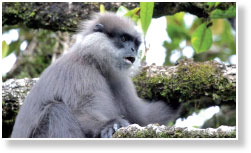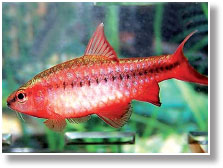Sri Lanka’s nature
inhabitants
Sri Lanka Blue Magpie
 The Sri Lanka Blue Magpie or Ceylon Magpie (Urocissa ornata) is an
endemic bird in Sri Lanka, part of the Crow family. Living in the
upcountry forests, it makes its home in the dense wet evergreens. It is
unfortunately on the decline due to loss of this habitat but several
research and studies are being done to protect the species as much as
possible. The Sri Lanka Blue Magpie or Ceylon Magpie (Urocissa ornata) is an
endemic bird in Sri Lanka, part of the Crow family. Living in the
upcountry forests, it makes its home in the dense wet evergreens. It is
unfortunately on the decline due to loss of this habitat but several
research and studies are being done to protect the species as much as
possible.
The Sri Lanka Blue Magpie is usually found in groups of up to six or
seven birds and it prefers to eat an omnivorous diet. Its cup-shaped
stick nest is in a tree or shrub and there are usually 3–5 brown-spotted
eggs that are laid. Similar to the European magpie, it can grow to a
length of 42–47 cm. The adults are blue with chestnut head and wings,
and a long white-tipped tail.
The legs and bill are red. The young bird is a duller version of the
adult. The Sri Lanka Blue Magpie has a variety of calls including
mimicry, a loud chink-chink and a rasping ‘krak-krak-krak-krak’. Known
as Kehibella in Sinhala, the Blue Magpie appears in a 10c Sri Lankan
postal stamp.
Here we identify some of Sri Lanka’s nature
inhabitants that can be found in the Galle rainforest.
Purple-faced Leaf Monkey
 The Purple-faced Langur (Trachypithecus vetulus), or Purple-faced
Leaf Monkey, is a species of Old World monkey endemic to Sri Lanka. This
is a long-tailed arboreal species, mainly brown with a dark facemask and
paler lower face. The loud barking call, particularly of the highland
form, can be mistaken for the roar of other predators. The Purple-faced Langur (Trachypithecus vetulus), or Purple-faced
Leaf Monkey, is a species of Old World monkey endemic to Sri Lanka. This
is a long-tailed arboreal species, mainly brown with a dark facemask and
paler lower face. The loud barking call, particularly of the highland
form, can be mistaken for the roar of other predators.
This was once a common species, which was found even in suburban
Colombo and in the wet zone villages, but rapid urbanisation has taken a
toll on the numbers of these monkeys.
It is said to be very selective in its diet, and its range has
contracted greatly in the face of human encroachment.
There are four distinct subspecies of Purple-faced Langur which are
the Southern Lowland Wetzone Purple-faced Langur, North Lowland Wetzone
Purple-faced Langur, Dryzone Purple-faced Langur and Montane
Purple-faced Langur or Bear Monkey.
Cherry barb
 The cherry barb (Puntius titteya) is a tropical fish belonging to the
spotted barb genus of the Cyprinidae family. It is native to Sri Lanka,
and introduced populations have become established in Mexico and
Colombia. The species is commercially important in the aquarium trade,
and the more colorful varieties are in danger of being over fished for
this industry. The cherry barb (Puntius titteya) is a tropical fish belonging to the
spotted barb genus of the Cyprinidae family. It is native to Sri Lanka,
and introduced populations have become established in Mexico and
Colombia. The species is commercially important in the aquarium trade,
and the more colorful varieties are in danger of being over fished for
this industry.
They were listed as a Lower Risk/conservation dependent species in
1996. The cherry barb is an elongated fish with a relatively compressed
body. Males are redder than females, and they attain a very deep red
colour when breeding. Females are lighter, with yellowish fins. The
cherry barb will grow to two inches (five centimeters) in length.
The Cherry Barb’s natural environment is one of heavily shaded,
shallow, and calm waters. Their native substrate is one of silt with
leaf cover. When breeding, males swim just behind females, and chase
away rival males. Adult cherry barbs will spawn 200 to 300 eggs and
scatter them on plants and on the substrate. |

